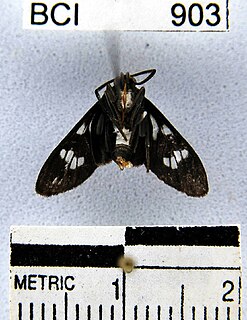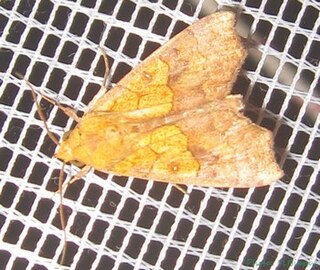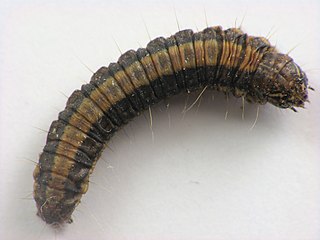
Nola is a genus of moths described by William Elford Leach in 1815. They are the namesake of the subfamily Nolinae and the family Nolidae. This genus occurs worldwide wherever suitable habitat is present.

Crambinae is a large subfamily of the lepidopteran family Crambidae, the crambid snout moths. It currently includes over 1,800 species worldwide. The larvae are root feeders or stem borers, mostly on grasses. A few species are pests of sod grasses, maize, sugar cane, rice, and other Poaceae. The monophyly of this group is supported by the structure of the tympanal organs and the phallus attached medially to the juxta.

Heliura is a genus of moths in the subfamily Arctiinae. The genus was erected by Arthur Gardiner Butler in 1876.

Idalus is a genus of moths in the family Erebidae. The genus was erected by Francis Walker in 1855.

Leucanopsis is a genus of moths in the family Erebidae. The genus was described by Alfredo Rei do Régo Barros in 1956.

Trichromia is a genus of moths in the family Erebidae erected by Jacob Hübner in 1819. The members of this genus are largely indigenous to South America.

Argyria is a genus of moths of the family Crambidae. The genus was described by Jacob Hübner in 1818.
Donacoscaptes is a genus of moths of the family Crambidae.

Haimbachia is a genus of moths of the family Crambidae.

Lamprosema is a genus of moths of the family Crambidae described by Jacob Hübner in 1823.
Myelobia is a genus of moths of the family Crambidae.

Phostria is a genus of moths of the family Crambidae.

Syllepte is a genus of moths of the family Crambidae.

Schoenobius is a genus of moths of the family Crambidae and tpical of the subfamily Schoenobiinae. Species are found mostly in Europe.

Scoparia is a grass moth genus of subfamily Scopariinae. Some authors have assigned the synonymous taxon Sineudonia to the snout moth family (Pyralidae), where all grass moths were once also included, but this seems to be in error.

Anomis is a genus of moths in the family Erebidae.

Scopula is a genus of moths in the family Geometridae described by Franz von Paula Schrank in 1802.

Desmia is a genus of moths of the family Crambidae. The genus was erected by John O. Westwood in 1832.

The Epipaschiinae are a subfamily of snout moths. Almost 600 species are known today, which are found mainly in the tropics and subtropics. Some occur in temperate regions, but the subfamily is apparently completely absent from Europe, at least as native species. A few Epipaschiinae are crop pests that may occasionally become economically significant.














